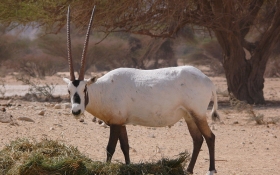
Arabian Oryx
Oryx leucoryx
Animal Behavior: Oryx are gregarious. Their normal group size is 10 animals or fewer, but as many as 100 individuals have been seen in one herd. Groups of bachelors are kept separately and establish a hierarchy amongst themselves through fighting and chases. When Oryx are not eating or wandering their habitat, they dig shallow depressions in the soft ground under shrubs and trees for resting.
Eating Habits: Oryx feed on diverse types of grasses and shrubs found in their arid habitat. They go to streams and water holes to drink. They can also obtain moisture from sources such as melons and succulent bulbs.
Range: Oryx leucoryx were originally found in Syria, Iraq, Israel, Jordan, Sinai, and the Arabian Peninsula.
Conservation Efforts: The last known individuals in the wild were killed in 1972, with unconfirmed reports from as late as 1979. In the 1950's efforts were made to establish captive herds. There are now approximately 500 individuals in the wild, 300 in captivity on the Arabian Peninsula, and 2,000 held elsewhere, such as Phoenix and San Diego Zoos. The Arabian Oryx is on the IUCH Red List as Endangered.
Animal Facts: A female can produce one calf once a year during any month. The longevity of these animals seem to be about 20 years. Oryx have been described as alert, wary, and keen sighted. They defend themselves by lowering their head so that their sharp horns point forward. There are many positive benefits for humans. The meat is greatly appreciated, their hides are valued for leather, and other parts have alleged medicinal uses. The head is also highly valued as a trophy.
